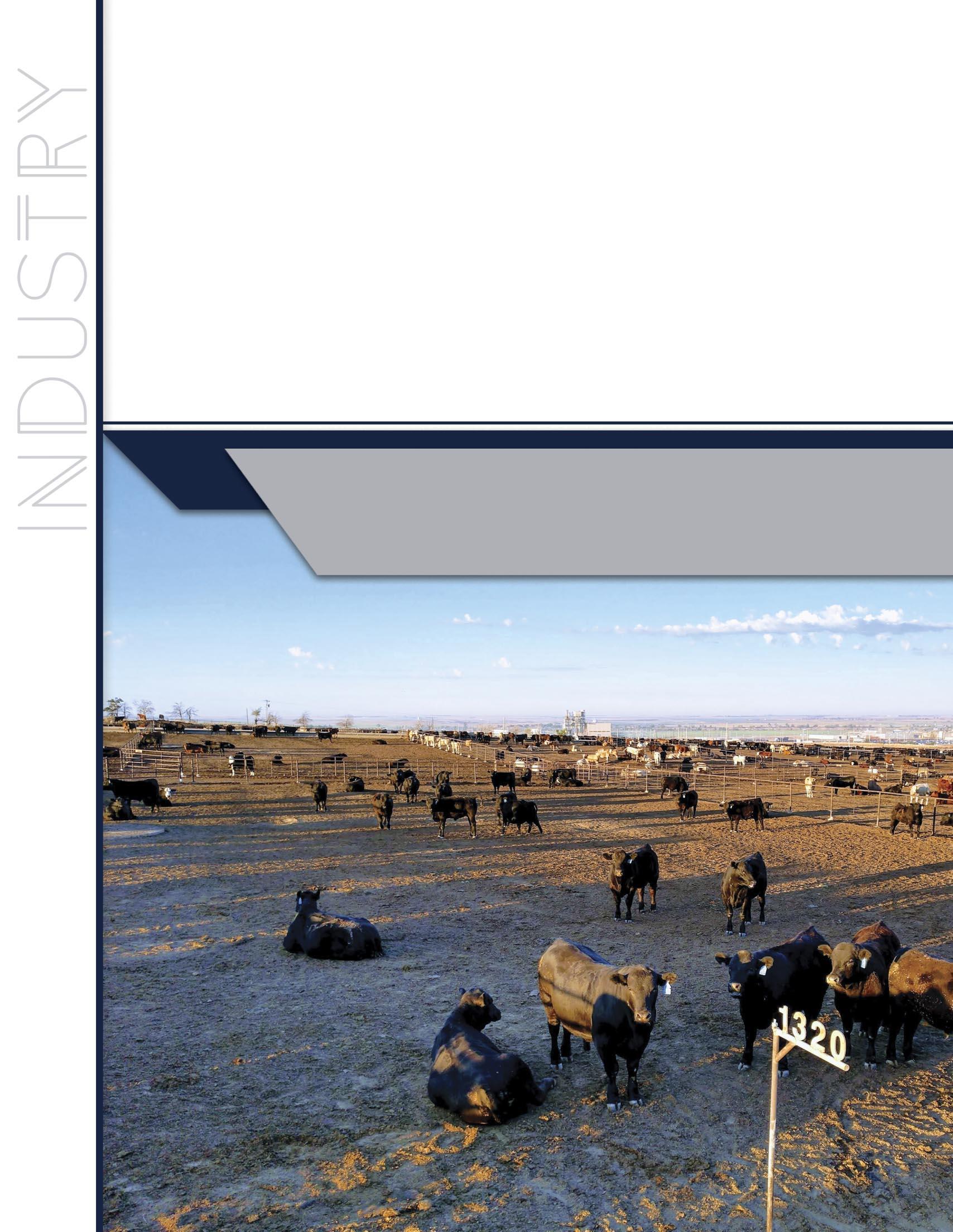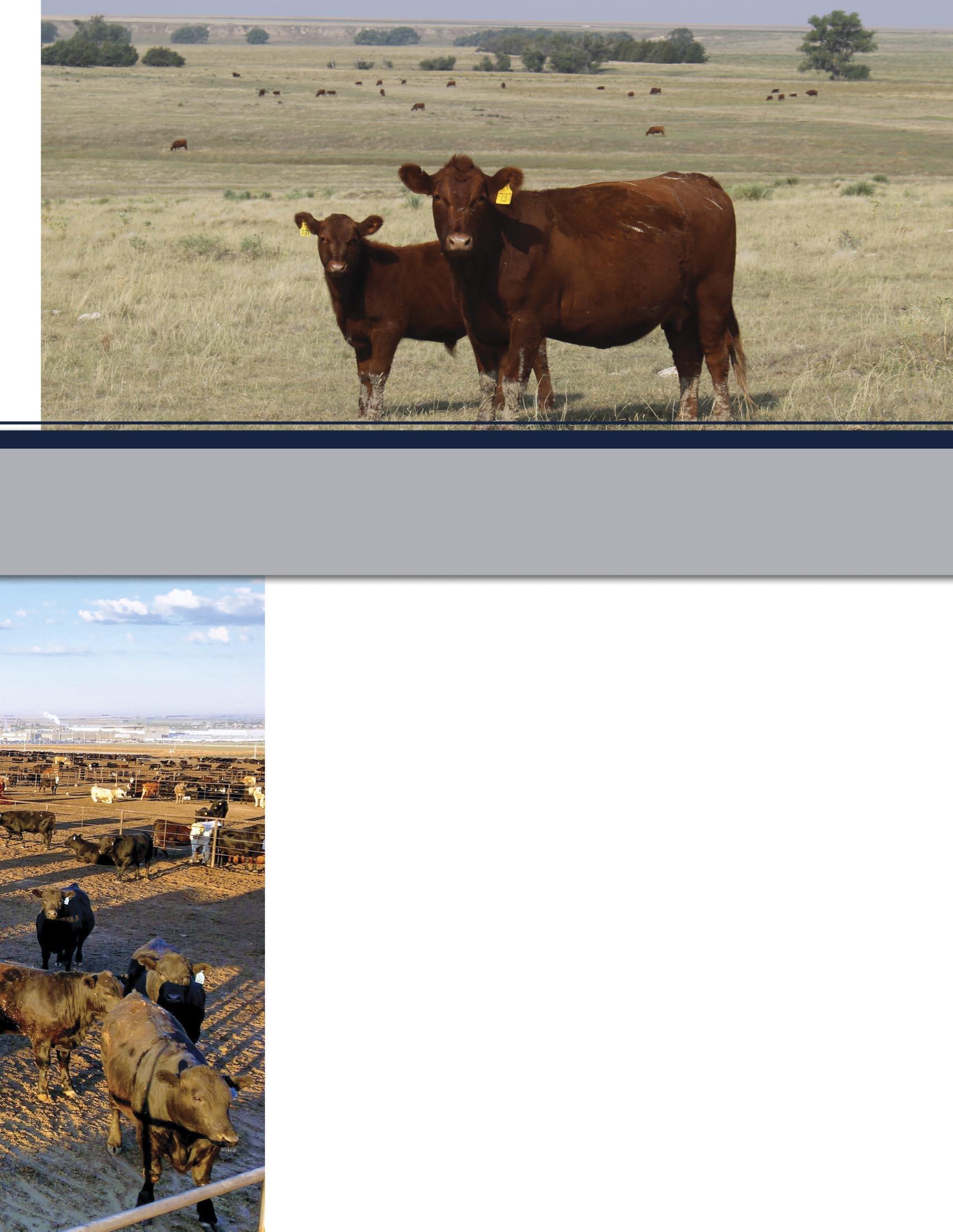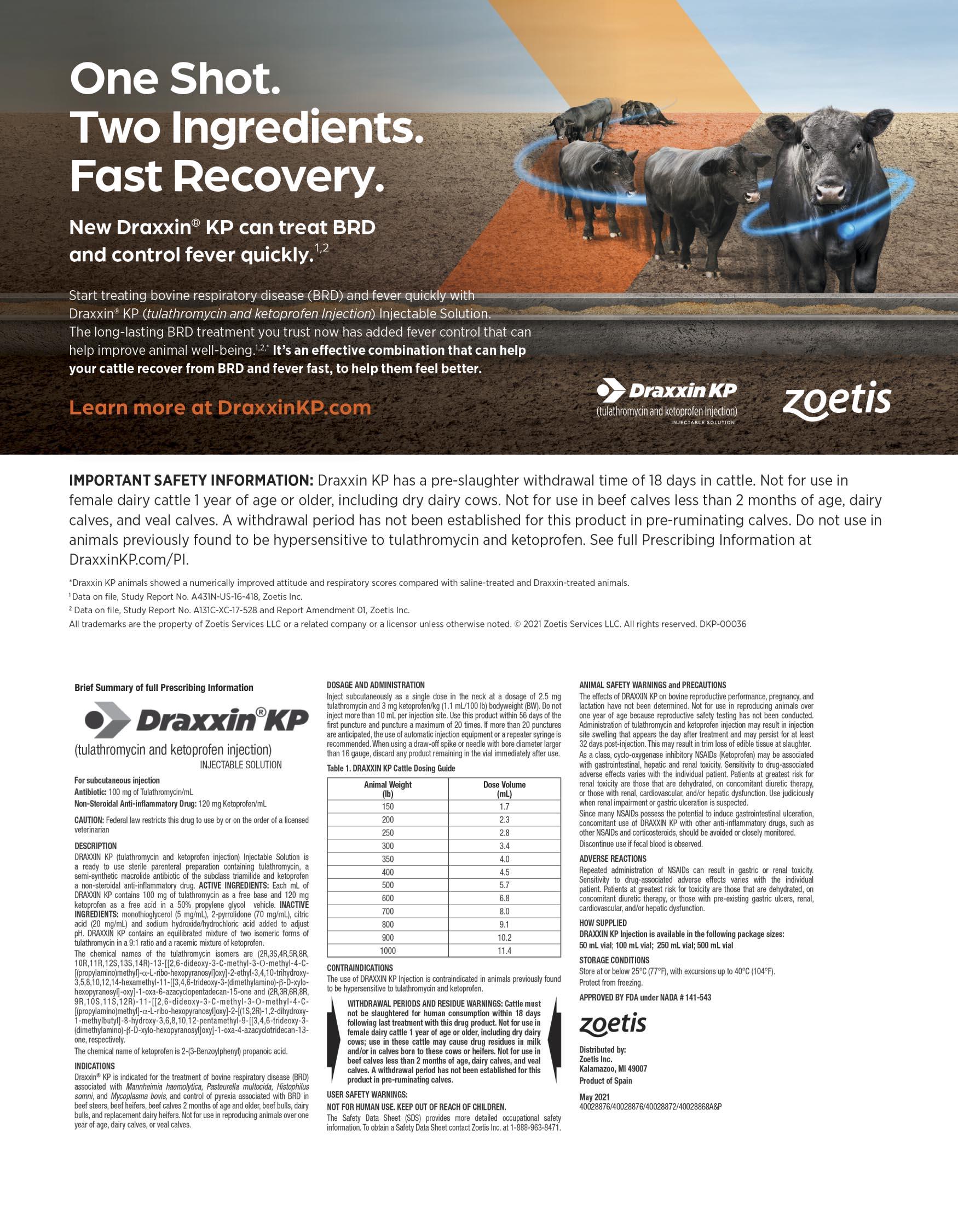
8 minute read
A PROACTIVE SOLUTION TO DISRUPTIVE CHANGES
By Callahan Grund, U.S. CattleTrace
For too long, the U.S. cattle industry has clung to normal, instead of using the disrupters we have faced to tackle challenges to our livelihoods in new and innovative ways.
We are finally approaching the sense of normal that our world felt before 2020. Months of wearing masks and avoiding public gatherings have passed, and now that our communities and industries have started to convene, there is no doubt that many of us have just lived through the greatest disruption of our times. With shortages of toilet paper, an extreme price jump in beef prices and the loss of a labor workforce, we have seen unprecedented changes in the flow of our day-to-day lives.


To put it simply, we are more globally connected than ever before. What was once an issue or opportunity in a country thousands of miles away can now be at our doorsteps in a matter of days. If there is anything that the progression of the COVID-19 crisis has taught us, it is that our dependence on the “normal” we all are comfortable in can be drastically altered in a mere moment.
Disruption constantly comes to mind for me when we discuss the pandemic in our human population. It is also the word that comes to mind we start discussions on the impact that a foreign animal disease (FAD) could have on not only our nation’s herd, but more importantly, our food supply.
That normality we have yearned for the past year will now come to be something entirely different. For too long, the U.S. cattle industry has clung to normal, instead of using the disrupters we have faced to tackle challenges to our livelihoods in new and innovative ways. The romantic nature of the western culture that we live in and the cattle industry that we love has sometimes enthralled us to long for the past rather than innovate and improve for the future.
As of 2019, of the top 10 beef exporting countries in the world, the United States of America and India are the only countries that do not have a robust national disease traceability system. With India’s primary export being water buffalo, this leaves the U.S. as the lone high-quality beef exporting nation without an end-to-end, robust disease traceability system. In comparison to the technology industry, any time a progression is made, we take extreme measures to ensure the security and safety of this new technology. The U.S. currently produces the highest quality, best tasting beef product in the world. If a foreign animal disease were to hit our nation’s cattle industry, the disruption would be devastating to “the way we have always done things”.
Disruption can occur at anytime and anywhere in our lives. The potential risk that a foreign animal disease could have on our industry may cost an exponential amount and have long lasting effects, similar to what we are seeing now in our new “normal”. We at U.S. CattleTrace are producers, just like many of you. Our mission is to create and build a voluntary contact tracing system for the beef industry that can be utilized during a disease outbreak. We aim to work with producers just like yourselves to proactively build out a system that works and integrates with the “way things have always been done” in the beef industry, while still crafting a functional contact tracing tool for animal health officials in the time of a disease outbreak.

For more information on how to join U.S. CattleTrace, contact us at 785-4568472 or visit uscattletrace.org.
Callahan Grund serves as the executive director for U.S. CattleTrace. Grund previously worked in policy engagement, business development and animal disease traceability preparedness at the Kansas Department of Agriculture. Grund has also served as the Director of Producer Relations with Farm Strategy, LLC, an agricultural start-up business in the grains sector. Originally from Sharon Springs, Kansas, Grund grew up on a registered Gelbvieh, Balancer and Angus seedstock cow-calf operation and is still highly involved today. He and his wife, Emily, also run a small cattle herd of their own near Wamego, Kansas.

FOCUS ON RETAINING THE GREAT PEOPLE WE CURRENTLY HAVE
Dr. Nels Lindberg, Production Animal Consultation

Regardless of the industry, maintaining enough team members to work is a challenge. We have all seen extreme situations, such as restaurants that can’t even open their doors to conduct business and create commerce. This is a day many of us never thought we would see.
As we find it more and more difficult to get people to apply or even “come in the door”, we need to shift our thoughts on taking care of the valuable team members we currently have. We must work very hard at keeping those that are currently under our care and leadership. We have current rockstars that will leave us if we do not take care of them because all businesses are hungry for help and willing to step up to the plate to attract talent.
One of the greatest intangible costs to a feedyard is employee turnover. We never can truly measure the tangible cost from an accounting basis, but in any industry, it is widely known that the greatest cost to any company is turnover. We as leaders must be intentional about retaining the incredible folks we have on our teams. Your ability to be a great leader is predicted by your ability to put the right people on the field. Time and money cost you “wins.”
Bill Belichick was 36-44 as the head coach of Cleveland Browns. He was 5-11 his first year at New England, and in 2001, he was winless until Tom Brady became the starting quarterback. With Brady as starting quarterback, Belichick’s teams are 136-39; without, they are 51-65. Talent matters. No one is irreplaceable, but talent retention matters, as this analogy demonstrates. If a rockstar feed crew leader leaves because they do not feel valued, we have not led them appropriately or we have not been very open in our all-around communication with them about their career, family, and success in life. It will cost the yard some “wins” in the feed column and maybe in the health column. Great yards pick up the pieces and move on after a key person leaves – that is just what they do – but it may sting for a bit. We want to retain our talent because, like Tom Brady, they are tough to replace.
All humans are given three things: talent (what you do well), passion (what you love), and mission (something you want to accomplish, give to the world, and be a part of). As leaders, it must be our goal to help our people do what they are good at with passion as part of a noble mission that gets results.
As we work to retain talent, our leadership team must work very hard to communicate to their team members what they do well, have heart-to-heart conversations with their team members about what they love, and routinely communicate the noble mission, purpose, and reason driving what we do every day.
The following are five key steps to retain your talented caregivers, feed crew, and maintenance team members.
1. Develop your people intentionally. Most people have a desire to be better, and it is up to their leaders to lead caringly enough to fire up that passion within them. Here are several action items for you and your teams:
• Have a self-improvement reading plan for your people (it could be on personal finances, parenting, leadership growth, family, etc.).
• Provide continual feedback on their work or their growth as a person. They are looking to you for approval of what they are doing or working on.
• Have them attend conferences that grow them personally and professionally.
Many leaders number one downfall is they think they already know it all on personal growth and leadership; otherwise, they would not be in those positions. The fact is, we all have continued, humbled learning and growing to do. As leaders we are either preparing or repairing. Let’s prepare, and let’s also invest in our valued team’s growth beyond the technical aspectof the job in a truly caring way that helps our people succeed at life! Be intentional about investing in their growth!
2. Recognize them intentionally. As Gen Xers and Boomers, we can be terrible at recognizing any kind of win, big or small. Our parents and leaders may have never recognized us individually for our wins at work or at home. They just expected us to keep making progress. But our people today want and crave recognition. Our hesitancy to pat them on the back for fear they have too much confidence or to routinely tell them “Good job!” for fear they may ask for a raise often factors into their decision to take steps towards leaving us. Get better at noticing people doing things right and recognizing them in front of the whole crew. The human soul thrives off a pat on the back in front of peers.
3. Reward them. Many men and women would rather be publicly recognized and rewarded than get a raise. Now, we do seem to live in a time of pay inflation, and maybe that is not all bad for our hard-working team members, but, beyond pay, how can we reward them for their long hours of hard work? Is it through periodic “Benjis”? Or is it through periodic beef days where you hand out several hundred frozen ribeyes? Or maybe lunch for the whole yard quarterly or monthly? Or maybe a custom-made piece of tack or an extra paid day off? Something even more simple that costs nothing is the reward of a handwritten letter or note of appreciation. When was the last time you did this? I promise, if you start hand-writing notes to your team members, the person receiving it may not say anything, but loyalty to you and your leadership will soar through the roof! Take action on this now!
4. Promote them. Some team members want an opportunity to grow and others do not, but it is our obligation to give them an opportunity to grow. Contrary to belief, this does not mean they take your job. It means we as leaders simply help our people grow professionally, personally, and for their family. (Do I sound like a broken record?) Most all people have a desire to grow and get better at life and at work under the right leadership. If we as leaders believe our people do not have a desire to do that, then we should likely take a look in the mirror. Now, there are also opportunities to discuss growth to higher levels within an organization with our people. As you see that potential in their daily behavior and as you grow them as a person, talk them through the expectations it takes to get promoted.

5. Keep them in their sweet spot. Many of our people fail in our yards because we elevate them into positions at which they are not capable of succeeding. We must evaluate our people for their ability to succeed at the next level instead of evaluating them based on their success at their current level. Some have what it takes at the next level and some have what it takes at the next level under our mentorship and leadership growth plan while others not only do not have the ability to succeed at the next level but also do not want to be pushed to that higher level. We must help our people understand their sweet spot and help keep them in that sweet spot for them and their success.
85% of the global workforce is not engaged and that is directly due to leadership. It is our job to engage our people to retain them. We as leaders are the lid on our talent. If we as leaders want to win, we must help grow our talent to win. Grow them as people across all aspects of life so that they can win at life. People want two things: income and impact! We as leaders can provide that by taking action on the items listed above. There is not an exact “grand plan” or “how to” book when it comes to attracting and retaining our people. It all starts with all these little action items that add up to the “grand plan” for people to have a desire to be under your leadership and stay under your leadership.











